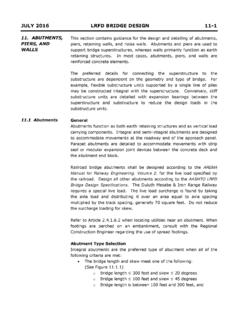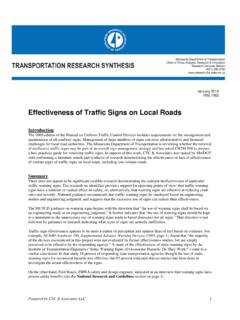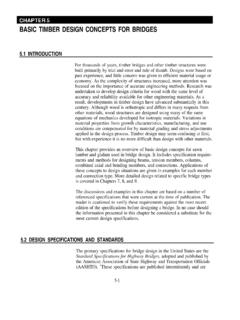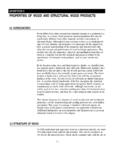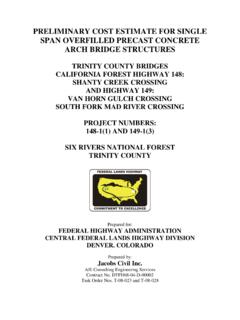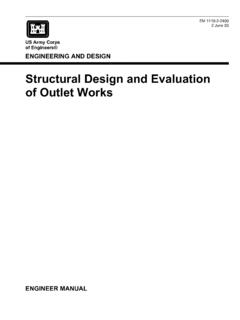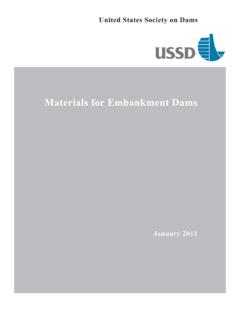Transcription of Appendix G. General Practice for Installing and Use of ...
1 12/10/2013 GEOTECHNICAL MANUAL. Appendix G. General Practice for Installing and Use of Settlement Plates Background Earth materials generally compress an observable amount when load is applied. Soils, in particular, when subject to load, may deflect, consolidate, or densify. Fill materials and native soils may react immediately, slowly, or very slowly, to loadings depending on the type of material and the effect of water on the soil system. The magnitude and rate of compression [or deflection] is often difficult to predict, particularly in cohesive, fine grained, soils such as silt and clay. Deformations in a soil system may be elastic or plastic in nature, or a combination of both. Sands (coarse grained). Sandy soils typically display immediate settlement characteristics. These soils consolidate very quickly (the time may vary from nearly instantaneous to several days). Often sands are assumed to have elastic properties and an associated value of material stiffness.
2 Settlement is not generally monitored where a site consists of exclusively sandy (granular) materials. The total strain for a given applied stress is often very small (a few percent), consequently overall deflections are also small. Clays (fine grained, cohesive). Clayey soils exhibit consolidation behavior which is fairly well understood, though complex. Stress history, mineralogy, age, moisture content, and geologic formation all play a role in the strength and behavior of clay materials. Generally, clays exhibit a roughly bi-linear behavior pattern. Clays respond to applied stress with relatively low strains until the maximum past pressure is applied, after this point, they tend to respond to increased load at a greatly increased rate of strain. The time rate of consolidation of clay materials is highly dependent on particle sizes of the soil and drainage paths. Thick deposits of high clay content materials may take years to consolidate, even under high stress.
3 Soils with greater silt content, or possessing favorable free drainage conditions (such as sand seams), may consolidate relatively rapidly. Organic Materials Organic soils are generally treated as a distinct material category as they contain relatively large amounts of, or exclusively, non-soil materials. Organic materials are subject to decay processes where the material chemically and structurally changes over time. This decay can have profound effects on the strength and behavior properties of the material. Organic soils are typically very dark in color, have very low dry unit weights, and have high moisture contents. Moisture contents in organic material may range from 30% to over 1000%. Texture may range 12/10/2013 GEOTECHNICAL MANUAL. from very fibrous to fluid muck. Typically, organic materials have very large strains associated with any loading condition in excess of the in-situ stress. Large stresses in high moisture peat deposits may result in strains well in excess of 50%.
4 Overall behavior is highly site specific. Consolidation behavior in organic materials is also less uniform as compared to mineral soils, sudden compression events' can occur where local changes in structure result in sudden deformations even at constant stress. For all geomaterials, behavior is dependent on the site geometry (layer thicknesses) and location of the water table, applied loading (stress) conditions, and material properties, such as density, permeability, overconsolidation ratio (OCR), and water content. General Use The most common settlement monitoring system is the settlement plate. These instruments may be simply constructed and read manually, or involve relatively complex fluid and electrical sensor systems for remote reading and automated recording. Settlement plates are typically installed in areas where significant settlement is predicted. They can be used to examine if predicted settlement: 1) is occurring 2) is occurring at predicted rates and magnitudes 3) has occurred to a magnitude of interest (or over a time of interest).
5 4) is substantially complete 5) is not occurring Settlement plates may also be installed to monitor heave, either caused by material displacement or frost. Settlement plates may be used alone or in conjunction with other instrumentation including horizontal inclinometers, piezometers, borehole extensometers, and hydraulic remotely-monitored settlement systems. Construction Typical settlement plate construction is outlined in the included diagram. The base platform is typically made of plywood but may also be a steel plate or concrete pad. A reference rod (riser pipe), with threaded end connections, is attached to the platform. As fill is placed over the settlement plate additional segments of pipe are added. Note that where high quality readings of the behavior at the plate elevation are of interest, and/or where extra protection is required, a PVC protection pipe should also be placed around the threaded riser pipe. The plastic pipe should be of sufficient diameter to accommodate any couplers used to connect the riser rods.
6 Settlement plates may be placed at any given elevation of interest. Typically they are installed on the existing ground surface prior to the construction of embankment fill. They may also be 12/10/2013 GEOTECHNICAL MANUAL. placed in excavations, at reinforcing interfaces, or within embankments to monitor settlement characteristics. Settlement is determined by periodically measuring the elevation of the top of the reference rod. The elevation of the base platform elevation must be measured before the embankment construction begins. Subsequent readings should be taken periodically during the embankment construction and whenever additional riser pipes are attached. Stable benchmarks should be used for a reference elevation datum and should be located away from all possible vertical movement or other disturbance. Depending on the importance of the installations it may be necessary to use multiple benchmarks for redundancy and survey elevations between them at regular intervals for validation.
7 Applications 12/10/2013 GEOTECHNICAL MANUAL. The Foundations Unit generally recommends the use of settlement plates where soil settlements have been predicted to be of a large (or undeterminable) magnitude, and could cause construction or operational difficulties to roadways or structures. Other units within Mn/DOT may specify the use of settlement plates if there is concern with respect to roadway or structural performance due to poor or unknown soil conditions. Bridge Abutment Foundations (Piling). Bridge Abutment Foundations (Spread Footings). Bridge Approach Embankments Embankments Waiting periods, if specified, should be adhered to. Failure to postpone construction until after consolidation settlement has been allowed to occur at problematic sites can result in significant construction difficulties, structural damage, delays, reconstruction, and associated incurred costs. Waiting Periods Settlement plates are frequently used where a waiting period for construction has been recommended.
8 Waiting periods are a minimum specified time to allow consolidation settlement to occur, generally after fills over soft or compressible soils or large fills have been placed. Waiting periods are determined from predictions based on the geotechnical site investigation and associated testing and analysis. Waiting periods are used to prevent pavement distress, differential settlement of hydraulic structures, curbing, wingwalls, or other structures, and to prevent pile dragload.' Pile dragload is a condition where compressible soils in or below the fill layer adhere to structural piling and impart an additional downward acting load into the pile as the soils consolidate, possibly overstressing it. Additionally, if the piling is not founded on a firm layer, settlements in the piling may be excessive due to the added load and reduced area of resisting soil support. Monitoring of the actual ground behavior, with settlement plates, can be used to determine if work may begin in advance of the minimum waiting period time.
9 It should also be noted that if settlement is excessive, the waiting period may be extended. Site Plan and Location Selection Settlement plates should be located such that construction traffic in the vicinity is minimized if at all possible. Plate installations and riser pipes should be clearly and adequately marked to 12/10/2013 GEOTECHNICAL MANUAL. protect the riser pipes from impact or obliteration during fill placement, grading, and other construction activities that will be ongoing during the monitoring process. Note also that the bench-mark (or fixed reference elevation) used to survey the settlement plates must also remain intact through the monitoring process. A stadia rod may be used to obtain the fill elevation if the top of fill is not visible from the survey point; both the elevation of the riser pipe and the top of fill should be surveyed for use in settlement data analysis. Installation Settlement plates should be installed prior to any addition of fill material.
10 Refer to the installation diagram [Figure , Mn/DOT Geotechnical and Pavement Manual, Part 1, April 1, 1994]. Ground elevation and the elevation of the settlement plate riser pipe should be established and recorded prior to placement of the fill material to establish a baseline reading. The plates should then be monitored regularly through the fill placement process and the following waiting period to determine the total soil movements, some of which occur during the fill placement process. It is important that the plates be surveyed immediately at the time of installation. For a typical bridge, consisting of two abutments, two settlement plates are installed. Note that settlement plates are generally not required at bridge piers, as there is usually a minimum of fill at these locations. A greater number of settlement plates may be warranted if fills are large in either height or lateral extent, if there is risk that they will destroyed by construction traffic, or for redundancy if the site is of particular importance.
